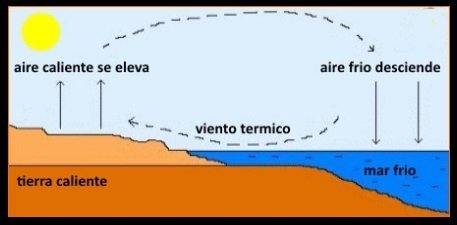With a size of 3,640 km2, and a coastline of 555 km, Mallorca constitutes a perfect space to receive a typical system of thermal winds during hot season. How is kitesurfing in Mallorca under thermal winds?
In the following lines we are going to try to explain how thermal winds influence the island of Mallorca, especially as weather propiciates warm temperatures over the land.
A thermal regime of breezes in summer which is created by the following situation: To the west of the Iberian peninsula, over the Atlantic, the surface dominance of the Azores High Pressure Area and the formation of a thermal low over Spain, together with a general circulation of winds from east component in the southwest part of the Mediterranean Sea.
During midd to late spring and throughout the summer season, the earth is heated by the influence of sun, causing the convection of superheated air over the surface of the island which in turn gives rise to the aspiration of cooler air from the sea creating what is known as “Embat“.
Thermal winds in Mallorca in June
The embat usually lasts between 6 and 8 hours, corresponding to a smaller duration on the interior of the island, and a longer duration on the coasts. This thermal winds are practically a constant in the months between June and end of August.
The intensity of this breezes goes between 3 or 4 knots and until 14 to 16 knots in its highest peak, being generally between 10 and 12 knots its average strength.
The Embat takes place around the island clockwise: NE in the bays of Pollensa and Alcudia, E-SE on the east coast of the island, SW in the south and NW in the West of Mallorca.

The sea air, cooler than the overheated air over the island, penetrates inland from different coastal origins depending on its orientation but mainly those of the two large bays of the north and south of the island, reorienting itself in function of the orography.
EMBAT / THERMAL SUMMER BREEZES
The sea breeze or Embat usually shows an orientation perpendicular to the coastline, also admitting its relation with some possible effects depending of any zone of high or less likely low pressure area in the greater or lesser proximity of the island, affecting in turn into a greater or lesser extent to the thermal air current, both in intensity and in variation of the angle in which that breeze enters over land.

The Embat in the eastern part of the island is less regular although sometimes the heated land create breezes that blows with greater intensity than the normal intensity, being in that case its predominant direction from the third quadrant -from South- instead of East or Southeast coming breezes, that is, when wind intensity rises. Then, as explained before, this it is due to the breeze which has rolled towards the South.